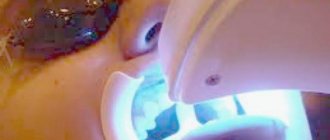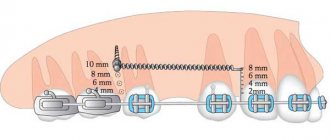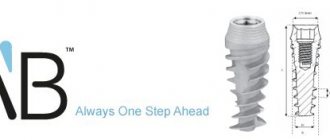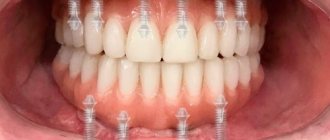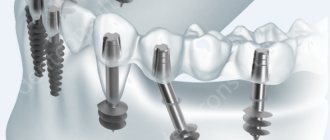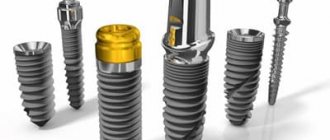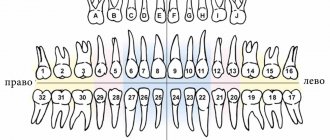Are you planning microimplant orthodontic treatment with the installation of braces? Perhaps you, as a potential patient, are considering microimplants as an alternative to traditional implants that are screwed into the bone? Everything you need to know about microimplants, indications for their use and possible contraindications is in our material. Experts share their independent opinions and reveal facts that are not always discussed in dentistry. Read the material to the end to be aware of all the important nuances.
Indications for the use of microimplants
- Orthodontic treatment. In orthodontics, mini-implants are used as additional support for a brace system. Their installation is required if selective correction of the position of the teeth is required. For example, if one tooth is displaced relative to its axis or has an incorrect position. However, all other teeth do not require correction. Fixing a brace on an adjacent healthy tooth can lead to the risk of it moving. A microimplant allows you to reduce this risk to zero. It is screwed into the gum and serves as a support for the braces system, balancing the pressure. The teeth move along the trajectory planned by the orthodontist. In this case, healthy units are not affected. After treatment is completed, the rod is removed.
- Orthopedic treatment. In orthopedics, microimplants are used as a support for removable dentures. To fix the prosthesis, it is usually necessary to implant 4-6 microimplants, after which the system copes well with the occlusal load. Due to their miniature size, they take root even in the upper jaw with bone atrophy. The microimplant can be loaded immediately after installation, without waiting for complete osseointegration. Compared to classic implantation, this is a less invasive procedure. Therefore, it is suitable as an alternative to conventional dental implantation for certain contraindications. A microimplant can be installed in case of bone atrophy, contraindications to osteoplasty, or complicated clinical picture.
When should microimplants be installed?
We bring to your attention two areas of clinical cases where patients usually require microimplants for treatment:
- Installation of a microimplant when correcting a patient’s bite. Here, a miniscrew is used to move teeth along the desired path as part of orthodontic treatment. Therefore, this group of microimplants is called orthodontic. For example, a patient needs to move one tooth without changing the position of the others. If you selectively move one tooth while supporting another (for example, the back one, as was done before the advent of orthodontic microimplants), there is a high probability that both teeth will move. In this way, the micro-implant helps balance the traction force, thereby helping to straighten natural teeth. After successful orthodontic treatment, the microimplant is usually removed.
- Installation of a microimplant during prosthetics. Microimplants serve as a good support for prosthetic structures - they are screwed into the bone. This is a more gentle treatment technology compared to implanting full titanium implants in patients. These microimplant solutions do not require a large amount of bone to be built up and cope well with the load. In most clinical cases, four to six microimplants are sufficient for one jaw to successfully install a prosthesis. Also, single dentures can be placed on micro-implants embedded shallowly in the bone, especially in cases where tooth implantation is required in the upper jaw (classical implants can affect the maxillary sinuses).
Dentistry for those who love to smile
+7
Make an appointment
Contraindications
Microimplants are less traumatic than conventional implants, but their installation has a number of contraindications. Most of them are not absolute. A final decision on the possibility of installing a microimplant will require examination and, possibly, additional treatment. Contraindications include:
- Diabetes mellitus in the stage of decompensation.
- Inflammation in the oral cavity.
- Gum diseases.
- Loose bone tissue.
- Mental illnesses.
- Oncological diseases.
Microimplants should not be placed on patients who smoke. Smoking slows down the healing process, which can cause various complications and reduce the effectiveness of orthodontic treatment. Therefore, patients who are not ready to give up the habit will have to use alternative options.
What advantages can be identified
Experts in the field of dentistry and orthodontics say that the use of orthodontic implants has many advantages over traditional braces treatment. Below are the key advantages of installing additional supports under the orthodontic structure:
- an excellent opportunity to enhance the impact on crooked teeth without the risk of loosening them,
- reduced treatment time (1.5-2 times),
- refusal to extract healthy teeth in order to free up free space,
- in a number of situations, it is possible to correct the position of teeth and jaws without surgical intervention (and not only in terms of tooth extraction, but also surgical displacement of the lower jaw),
- minor tissue trauma during implantation of structures,
- the ability to install fewer plates and avoid fixing unattractive facial devices to correct existing defects,
- Possibility of implantation into various parts of the jaw.
Patient history
“They put these small implants on my bottom row. You need to pull the sixes and eights back to free up some space in the front. The implants were fixed behind the sevens, and when you smile they are not visible at all. They implanted it quickly, I didn’t feel any severe pain. True, then, already at home, my jaw began to tug a little, I had to take a painkiller. The next day I went to the appointment again to have the rods attached. I stopped feeling the implants in my mouth after just a few days, I got used to it very quickly.”
Maria S., 29 years old, from correspondence on a thematic forum
Miniature implants are created from biocompatible materials, so the risk of their rejection or complications is minimized. The installation procedure is quick and painless.
Advantages of microimplants in orthodontic treatment
- Reducing treatment time. During orthodontic treatment, the patient wears a non-removable corrective appliance for a long time. The use of microimplants allows you to reduce the time required for bite correction.
- Lightening the braces system. In traditional treatment, additional elements are used to provide a counterweight, which are attached to the braces. This makes the structure heavier and can cause discomfort for the patient.
- Correction accuracy. The pressure force of the bracket system and the speed of tooth movement are planned at the preparatory stage of orthodontic treatment. Since microimplants, rather than your own teeth, are used as support for braces, a more accurate calculation can be made.
- Good survival rate. Despite the fact that microimplants are a relatively new technology in orthodontic treatment, we can already say that they take root well and do not cause complications. There is no risk of rejection, inflammation, or damage to bone tissue. Therefore, mini implants can be used even in patients with thinning gums.
- Installation in the right place. The microimplant is short in length, so it can be implanted anywhere in the gums. On the upper jaw they can be installed next to the maxillary sinuses. There is no risk of damaging them during implantation.
- Easy to remove. For orthodontic treatment, a titanium screw is installed for a period of about six months. After which it is removed from the gums without damaging the tissue.
How much do mini implants cost?
Many people are concerned about the cost of mini-implants. As already mentioned, the price of mini-implants is lower than that of classical systems. This is especially true for top-end structures, the installation of which can cost 50 thousand rubles or more. The price of one mini-implant averages 12 – 15 thousand rubles. At the same time, a single installation of a mini-implant is used mainly only in orthodontics: a larger number is required for orthopedic treatment. The price for prosthetics with mini-implants is approximately 90 – 120 thousand rubles. The total amount depends on the manufacturing company, the quality of the orthopedic design, as well as the level of the dental clinic in Moscow where the treatment is carried out.
Advantages of microimplants in prosthetics
- You can do without bone grafting. For primary stabilization of the implant, a sufficient amount of bone tissue is required. If a tooth has been lost for a long time, the bone will atrophy. A traditional implant can be installed only after osteoplasty. Microimplants require less bone volume, so they can be implanted in patients with bone atrophy.
- Can be used for immediate load protocols. The microimplant is able to withstand occlusal load normally. Therefore, such systems can be used for implantation with immediate loading of a lightweight adaptive prosthesis. Immediately after the operation, the patient can lead a normal life, following the doctor’s recommendations.
Installation of a microimplant is a minimally invasive procedure. The rod is screwed through a puncture in the gum, so there is no need for suturing. The risk of infection, rejection, and peri-implantitis is minimal.
In what cases is installation contraindicated?
There are not many restrictions here, but they are quite significant. Orthoimplants are not implanted if the patient is diagnosed with acute diabetes, the person suffers from severe alcohol or drug addiction, as well as diseases for which any surgical procedures are prohibited. Such pathological conditions include serious disorders in the functioning of the respiratory system, heart and blood vessels, diseases of the hematopoietic organs, and oncology. Among other limitations, experts also highlight inflammation of bone tissue.
Implantation stages
Just like before classical implantation, the installation of microimplants requires a preparatory stage and diagnostics. The implantologist prescribes an instrumental examination: x-ray, panoramic image, computed tomography. The images help to assess the location of teeth and their roots, the volume and density of bone tissue. Using the images, the doctor makes 3D modeling and plans the operation.
Oral preparation will also be required. It is necessary to undergo examination by a dentist. If caries or other oral diseases are detected, they are first treated. If there are contraindications, consultation with a specialized specialist may be required.
If there are no contraindications, the doctor will prescribe the procedure. The implantation of microimplants is a minimally invasive operation that takes about 15 minutes. The installation is done under local anesthesia. In some cases, if there are indications, for example, the patient’s panic, sedation is used.
The surgical stage does not require cutting the gum and its subsequent suturing. The implantologist makes a small puncture into which a screw is screwed. Since mini-implants have good primary stabilization, an orthodontic appliance or an adaptive prosthesis can be installed immediately.
After completion of the procedure, the doctor will give recommendations for oral care. If necessary, he will recommend anti-inflammatory and painkillers. Despite the fact that the implantation of microimplants is a gentle, low-traumatic procedure, in the first days there may be pain, swelling of the gums, and slight bleeding. These are normal phenomena that will go away on their own within 2-3 days.
Skeletal support in orthodontics
Stable support is the main task in the treatment of malocclusion. The force generated by orthodontic appliances changes the position of individual teeth. In order for this force to act in the intended direction, it is necessary to minimize the undesirable effects of opposing forces by using appropriate anchorage.
It is important to understand that reliable fixation of orthodontic appliances significantly affects the results of orthodontic treatment, and high-quality skeletal support is possible thanks to miniscrews. Orthodontic miniscrews:
- prevent unwanted tooth movement, and at the same time they help move problematic teeth in the planned direction
- reduce treatment time
- allow you to make minor corrections without having to install permanent braces on all your teeth.
How do microimplants differ from traditional implantation systems?
The main design difference is the size of microimplants. They are much smaller than traditional implant systems. They also differ in purpose of use. Their main purpose is orthodontic treatment. This is a temporary structure that will act as additional support for the braces system. After treatment is completed, the screw is removed from the gum. In prosthetics, microimplants are used to fix lightweight removable dentures when it is not possible to do full-fledged dental implantation.
Dental implants are intended for the treatment of edentia, including complete edentia. They replace the root of the tooth and serve as a support for a fixed prosthesis. Good survival rate and long service life are very important for dental implants. Micro implants are usually removed several months after treatment is completed.
Mini dental implants and mini implantation
Mini-implantation is one of the youngest trends in dentistry. Mini dental implants were developed in the USA in the early 2000s, and since about 2004, the technique has been actively used by specialists from Europe. In dentistry, mini dental implants are titanium pins with a diameter of about 2 millimeters: they are almost four times smaller than classic dental implants, so they can be used in very limited spaces. As a rule, mini-implants have a one-piece design that combines a titanium rod and an abutment on which an orthopedic structure is attached. Today, mini dental implants are produced by many top manufacturers, including companies such as Nobel Biocare, XiVE and Zimmer.
- Mini implants can be installed even in very limited spaces.
- Installation of mini-implants does not require bone grafting.
- Possibility of immediate prosthetics with a removable structure after the surgical stage.
- Fast healing time and non-traumatic installation of mini-implants.
- Removable dentures on mini-implants at a price significantly lower than designs using classic dental implants.
- Limited application possibilities. Impossibility of single crown prosthetics and installation of fixed structures.
- Complete osseointegration does not occur.
- More complex hygiene.
Mini-implants for fixing removable dentures
The upper part of mini-implants (abutment) has the shape of a ball. A metal base with a rubber ring fitted to it is installed in the prosthesis. The design is fixed by snapping when the ball hits the hole. The rubber seal eliminates the vertical movement of the prosthesis and prevents discomfort while eating or talking. A prosthesis fixed in this way on mini-implants cannot fall out.
What is the procedure for installing a microimplant?
Since the implant is installed near the tooth roots, the patient undergoes an x-ray before implantation. The image allows the orthodontist to install the structure so as not to injure the root.
The procedure lasts no more than 10–15 minutes and, in order not to take the patient out of his comfort zone, is performed under anesthesia. The mucous membrane is treated with an anesthetic spray and a pain-relieving injection, traditional for dental procedures, is performed. When tissue numbness occurs, an implant is screwed into the bone tissue in a selected location between the roots of two adjacent teeth through the gum mucosa. During the correction, the devices necessary to create orthodontic traction will be attached to its head protruding above the gum. At first, the patient experiences a feeling of fullness and pressure, which goes away over time. All implants placed will be removed from the bone when the correction goal is achieved.
Vector Tas system components
The anchorage system includes the following elements:
- Set of microscrews/implants.
- Tools: screwdrivers with removable tips, hammer drills for installing and removing microimplants, pilot burs.
- A set of nickel-titanium springs, 5 and 10 mm long, to create an active tension force of 50, 150 and 250 g.
- A deltoid-shaped slip ring placed on the implant to prevent twisting.
- Clamping hooks - to create force in the desired direction.
- Additionally - a needle-free anesthetic device.
Vector Tas Design
Microimplants are made from durable and biocompatible titanium. Their design consists of the following parts:
– a triangular cap (for an instrument) with a smooth surface and soft contours that do not injure the mucous membrane;
– a cylindrical part with a hole for spring and elastomeric rods;
– a round stopper to support the implant on the mucous membrane, as well as to prevent the growth of soft tissues;
– a cylindrical transmucosal ring that prevents the penetration of bacteria between the implant and soft tissues and prevents the screw from growing into them;
- a thread with a pointed end that easily fits into the bone.
Vector Tas have two types of threaded components:
- Self-tapping, designed for installation between tooth roots in thin bone.
- Non-self-tapping, installed in dense bone (after drilling), if the implant will not come into contact with the root.
The body of the microimplant, which enters the mucosa and bone, consists of a transmucosal ring and a threaded part. Its parameters:
– with self-tapping thread – diameter 1.4 mm, length – 6 and 8 mm;
– with non-self-tapping – diameter 2 mm, length – 10 and 12 mm.
Comparison with other implants
Omerelli Emir Romanovich, maxillofacial surgeon-implantologist and candidate of medical sciences, work experience: more than 13 years
In principle, it makes no sense to compare mini-implants and other types of artificial roots.
The small size was created specifically to support removable dentures to alleviate the plight of patients with insufficient bone volume in the oral cavity. After all, even special products like Corega cannot 100% cope with this problem, especially on the lower jaw. However, other types of implants for effective prosthetics are more common in dentistry.
Ask a Question
Price
- Primary appointment (examination, consultation) with a dentist (special offer) 100001
For free
Promotion
- Dental prosthetics using implants Acrylic covering prosthesis with a cast frame made of CoCr alloy (excluding the cost of fixing elements: locators, spherical abutments) 154001
60 000 ₽
- Intraosseous dental implantation of a temporary mini-implant Osstem (South Korea) 170025
9 000 ₽
- Intraosseous dental implantation of a spherical mini-implant Osstem (South Korea) 170026
14 000 ₽
Mini-implantation is the installation of small implants for comfortable use of removable dentures. Row reconstruction using classical implantation is not suitable for all patients. The method is technically complex, has contraindications and is quite expensive. As an alternative, patients are offered removable dentures, but the use of dentures is accompanied by a lot of inconvenience. To level them, they resort to mini-implantation.
Features of prosthetics on the lower and upper jaw
For full jaw prosthetics, a minimum of 4 mini-implants are required. The degree of fixation of this design corresponds to a prosthesis on two full-fledged artificial roots. But the stability is higher, because 4 micro-roots are distributed throughout the jaw, and the classic ones are installed only in the frontal zone, so the structure will be balanced.
The designs differ from traditional removable dentures:
- The shape of the upper jaw prosthesis with mini implants is smaller, without an artificial palate. Diction is not impaired, taste perception does not deteriorate.
- When lower jaw prosthetics do not require the use of special gels to improve fixation.
Care
After the prosthesis has been installed, you must first choose a more gentle diet and care regimen. Next you should follow simple rules:
- regular brushing;
- rinsing after meals;
- use of thread, irrigator;
- Visit the dentist's office regularly.
Experts recommend removing the denture once a week and thoroughly cleaning all elements, preferably using dental antiseptics.
